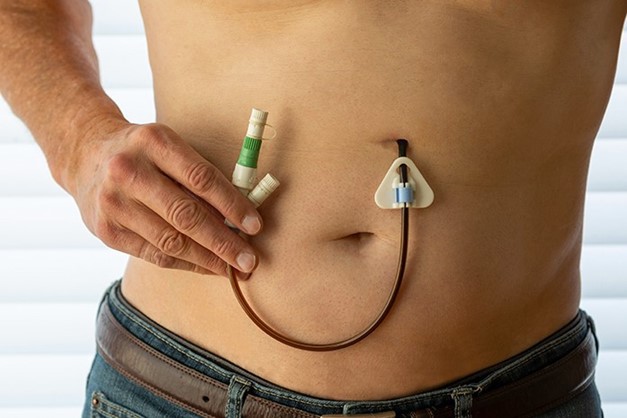A nurse is mixing a short-acting insulin and an intermediate-acting insulin in the same syringe for a client who has diabetes mellitus.
Which of the following actions should the nurse take first?
Draw the intermediate-acting insulin into the syringe.
Draw the short-acting insulin into the syringe.
Inject air into the intermediate-acting insulin vial.
Inject air into the short-acting insulin vial.
The Correct Answer is C
A. When mixing insulins, you should draw the short-acting insulin into the syringe first. This is done after injecting air into both vials (first into intermediate-acting, then into short-acting). Drawing intermediate-acting insulin first can contaminate the short-acting insulin vial with the longer-acting solution, which could alter the effectiveness of future doses.
B. Although this step is required when mixing insulins, it is not the first step. The nurse should first inject air into both vials to maintain vial pressure.
C. The nurse should inject air into the intermediate-acting insulin vial first because it helps prevent contamination and maintains the correct pressure within the vial. Intermediate-acting insulin, typically NPH (Neutral Protamine Hagedorn), is cloudy, and air injection into the vial allows for easy withdrawal later on without disrupting the order of mixing.
D. Injecting air into the short-acting insulin vial is necessary but should be done after injecting air into the intermediate-acting vial. By injecting air into both vials first, the nurse prevents a vacuum effect, which can make it difficult to draw up the insulin. After injecting air, the nurse can draw the short-acting insulin into the syringe before moving to the intermediate-acting insulin. This order minimizes the risk of contamination.
Nursing Test Bank
Naxlex Comprehensive Predictor Exams
Related Questions
Correct Answer is C
Explanation
This statement indicates that the client will be provided with information about advance directives before making a decision.
Advance directives are legal documents that allow individuals to communicate their wishes for medical treatment in the event that they are unable to make decisions for themselves.
Choice A is wrong because signing advance directives is not a requirement for undergoing surgery.
Choice B is wrong because the provider does not need to sign the advance directives.
Choice D is wrong because the presence of a partner is not required when signing advance directives.
Correct Answer is A
Explanation
According to a study published on PubMed, it is appropriate to change alimentation tubes and feeding bags every 72 hours rather than every 24 hours.

Choice B, Aspirate residual volume every 4 hr, is not necessary for continuous enteral feedings through a gastrostomy tube.
Choice C, Flush the tubing with 10 mL of water every 2 hr, is not necessary for continuous enteral feedings through a gastrostomy tube.
Choice D, Heat the formula to 40.5° C (105° F), is not necessary for continuous enteral feedings through a gastrostomy tube.
Whether you are a student looking to ace your exams or a practicing nurse seeking to enhance your expertise , our nursing education contents will empower you with the confidence and competence to make a difference in the lives of patients and become a respected leader in the healthcare field.
Visit Naxlex, invest in your future and unlock endless possibilities with our unparalleled nursing education contents today
Report Wrong Answer on the Current Question
Do you disagree with the answer? If yes, what is your expected answer? Explain.
Kindly be descriptive with the issue you are facing.
